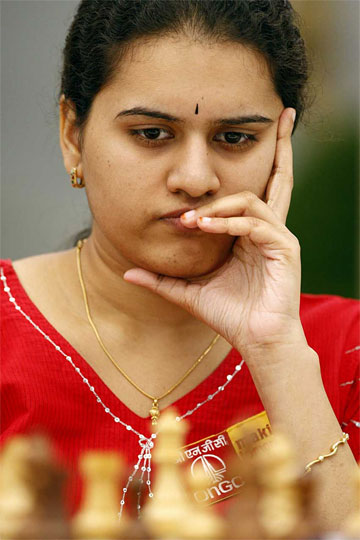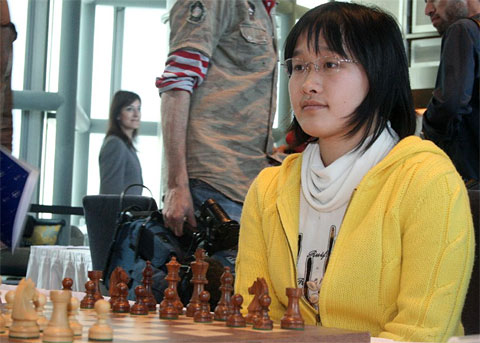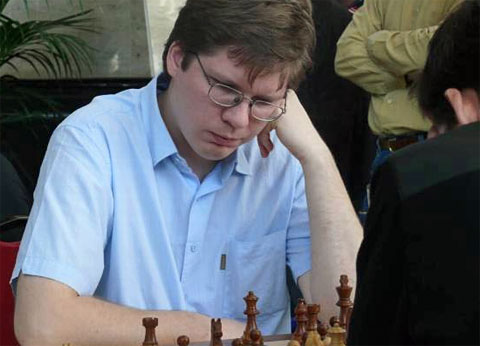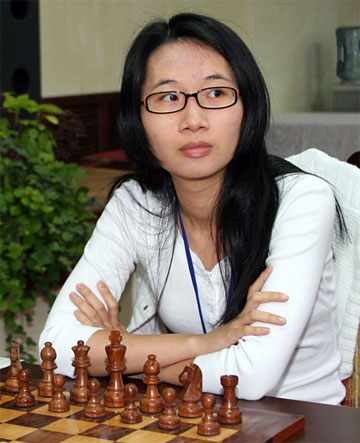| Latest | Greatest | Lobby | Journals | Search | Options | Help | Login |
|
|
|
This topic is archived. |
| Home » Discuss » Topic Forums » Sports |
|
| Jack Rabbit
|
Sun Mar-22-09 02:32 AM Original message |
| The Jack Rabbit Chess Report (March 22): Warning -- high estrogen content this week |
|
Koneru wins Women's Grand Prix
 Grandmaster Koneru Humpy of India, 22, the second ranked woman chess player in the world behind Judit Polgar, won the Women's Grand Prix in Istanbul Thursday when she defeated French grandmaster Marie Sebag in the eleventh and final round. The victory allowed Ms. Koneru step ahead of Chinese grandmasters Hou Yifan and Zhao Xue, with whom she was tied for first at the start of the final round, and withstand a bid from Armenian IM ELina Danielian, whose charge in the last round brought her to tied for second with Ms. Hou. Ms. Danielian won her final game against Ms. Zhao, while the fifteen-year-old Ms. Hou drew her last game with compatriot Yang Shen. Ms. Danielian's last-round victory was her third in four games. She also earned her second grandmaster norm with her performance. Tomashevsky wins European Championship  Russian grandmaster Evgeny Tomashevsky outlasted the field in a 11-man playoff Wednesday to claim first prize in the general competition of the 10th European Individual Championship in Budva, Montenegro, on Wednesday. Tomashevsky defeated compatriot Vladimir Malakhov in the fianl round of rapid and blitz games and took home the gold medal. Malakhov was awarded the silver while Georgian GM Baadur Jobava won the broze when he outscored Ernesto Inarkiev of Russia in a pair of rapid games. In addition to the gold medal, Tomashevsky took home �15,000. Tanya Kosintseva wins European Women's Championship  Russian IM Tatiana Kosintseva, younger sister of reigning Russian women's champion Nadezhda Kosintseva, won her second European women's title by defeating Armenia's Lilit Mkrtchian (Mah KUHT chee an) in a playoff round Friday in St. Petersburg. Ms. Kosintseva and Ms. Mkrtchian were tied for first place at the end of the 11-round event Thursday with 8� points apiece. Ms. Kosintseva also won the 2007 European women's championship in Dresden. The bronze medal also needed to be determined in a playoff among the seven ladies tied for third place with 8 points each. When the smoke cleared, the bronze went to Natalija Pogonina of Russia, who also won the women's competition at the Moscow Open last month. Melody Amber Tournament underway in Nice The annual Melody Amber Rapid/Blindfold Tournament began last weekend in the French Mediterranean town Nice. Twelve players play two games of chess a day for 11 rounds. In the moning, the players play a blindfold game and then in the afternoon each plays a rapid game against the same opponent as the morning, but with the colors reversed. After seven rounds, reigning world champion Vishy Anand of India and former world champion Vladimir Kramnik of Russia are leading the overall standings with 9 points each, although neither man is leading in either of the two evnets. In the blindford competition, Magnus Carlsen of Norway leads with 5� points, a half point ahead of Kramnik and a full point ahead of Anand. However, Carlsen has only 3 points out of seven in the rapid event. In the rapid games, American GM Gata Kamsky, who has only 2 points in the blindfold play, leads with 5 points, with Anand and Armenian GM Levon Aronian a half point back and Kramnik just another half point behind them. Carlsen and Aronian are tied for third place in the overall standings with 8� points each out of 14. The tournament is scheduled to conclude Friday. Calendar Reykjavik Open 23 March.-2 April. Dubai Open 3-13 April. Gausdal Chess Classic (Norway) 7-15 April. Foxwoods Open, Mashantucket, Connecticut 8-12 April. Russian Club Cup (Team Championships), Sochi 30 April-12 May. US Chess Championship, St. Louis May. Exact dates TBA. MTel Masters, Sofia 9-19 May. Asian Championships, Subic Freeprot (The Philippines) 12-23 May. Chicago Open 22-25 May. Aerosvit International Tournament, Foros (Ukraine) 9-20 June. World Open, Philadelphia 29 June-5 July. Canadian Open, Edmonton 11-19 July. Czech Open, Pardubice 16 July-2 August. Biel Chess Festival 18-31 July. FIDE Grand Prix, Yerevan. 8-24 August. |
| Printer Friendly | Permalink | | Top |
| Jack Rabbit
|
Sun Mar-22-09 02:34 AM Response to Original message |
| 1. This week's games |
|
Your humble hare acknowledges the assistance of Fritz 6.0 on analysis. Diagrams on the Jack Rabbit Chess Report are made with Chess M�rida, a true type font that can be downlaoded free here. !""""""""# $tMvWlVmT% $OoOoOoOo% $ + + + +% $+ + + + % $ + + + +% $+ + + + % $pPpPpPpP% $RnBqKbNr% /(((((((() WHITE White to move (This position is a theoretical draw) |
| Printer Friendly | Permalink | | Top |
| Jack Rabbit
|
Sun Mar-22-09 02:39 AM Response to Reply #1 |
| 2. Women's Grand Prix, Istanbul |
| Printer Friendly | Permalink | | Top |
| Jack Rabbit
|
Sun Mar-22-09 02:41 AM Response to Reply #2 |
| 3. Sebag - Koneru, Round 11 |
 Koneru Humpy Marie Sebag - Koneru Humpy Women's Grand Prix, Round 11 Istanbul, 19 March 2009 Spanish Grand Royal Game: Keres Defense 1.e4 e5 2.Nf3 Nc6 3.Bb5 a6 4.Ba4 Nf6 5.0-0 Be7 6.Re1 b5 7.Bb3 d6 8.c3 0-0 9.h3 a5!?
10.d3
10...a4 11.Bc2 Bd7
12.Nbd2 Re8 13.Nf1 h6
14.Ng3 Bf8 15.Nh2
15...Ne7!?
16.Qf3
16...Ng6 17.Ng4!?
17...Nxg4 18.hxg4 Be7
19.Nf5 Bg5 20.g3 Bxc1 21.Raxc1 Qg5!
22.Rcd1 Be6 23.a3 Rad8 24.Ne3
24...Nf8 25.d4
25...Nh7 26.Bd3 Bd7
27.Qe2 c6?!
!""""""""# $ + Tt+l+% $+ +v+oOm% $ +oO + O% $+o+ O W % $o+ Pp+p+% $P PbN P % $ P +q+ +% $+ +rR K % /(((((((() WHITE: Marie Sebag Position after 27...c7c6 28.d5!
28...cxd5 29.Bxb5 Bxb5
30.Qxb5 dxe4 31.Rxd6 Ra8 32.Rd7?!
32...Nf6 33.Rb7 h5
34.Qc4
34...Rf8 35.gxh5 Qxh5 36.Nd5?
!""""""""# $t+ + Tl+% $+r+ +oO % $ + + M W% $+ +nO + % $o+q+o+ +% $P P + P % $ P + P +% $+ + R K % /(((((((() WHITE: Marie Sebag Position after 36.Nf6d5 36...Ng4!
37.Kf1 Qh2
38.Ke2 Qxf2+ 39.Kd1 Rad8
40.Rb5
40...Ne3+ 41.Rxe3 Qxe3 42.Kc2
42...Qf2+ 43.Kb1 Rfe8 44.Ka2
44...e3!
45.Qb4 !""""""""# $ + Tt+l+% $+ + +oO % $ + + + +% $+r+nO + % $oQ + + +% $P P O P % $kP + W +% $+ + + + % /(((((((() WHITE: Marie Sebag Position after 45.Qc4b4 45...Rxd5!!
46.Rxd5 e2 47.Qxa4 Rb8 0-1
|
| Printer Friendly | Permalink | | Top |
| Jack Rabbit
|
Sun Mar-22-09 02:53 AM Response to Reply #2 |
| 4. Danielian - Zhao, Round 11 |
|
Elina Danielian of Armenia made a late charge from the pack to finish tied for second with Hou Yifan. She earned her second grandmaster norm in the process.
Elina Danielian Elina Danielian - Zhao Xue Women's Grand Prix, Round 11 Istanbul, 19 March 2009 East India Game: Queen's Indian Defense 1.d4 Nf6 2.Nf3 e6 3.e3 b6 4.Bd3 Bb7 5.0-0 c5 6.c4 Be7 7.Nc3 cxd4 8.exd4
8...d6
9.a3
9...0-0 10.d5
10...exd5
11.cxd5 Nbd7 12.Re1
12...Re8 13.Bf4 a6 14.Nd4!?
14...Bf8!?
15.Rxe8 Qxe8 16.Nf5 Ne5 17.Bf1
17...g6 18.Bg5
18...Ned7?
19.Nh6+ Kh8
!""""""""# $t+ +wV L% $+v+m+o+o% $ + O MoN% $+ +p+ B % $ + + + +% $P N + + % $ P + PpP% $R +q+bK % /(((((((() WHITE: Elina Danielian Position after 19...Kg8h8 20.Qd2!
20...Bg7 21.Re1 Qf8 22.Qf4 Rc8
23.Qxd6!
23...b5 24.Qxf8+ Bxf8
!""""""""# $ +t+ V L% $+v+m+o+o% $o+ + MoN% $+o+p+ B % $ + + + +% $P N + + % $ P + PpP% $+ + RbK % /(((((((() WHITE: Elina Danielian Position after 24...Bg7f8:Q 25.Nxf7+!
25...Kg7 26.Ne5 Nxe5 27.Rxe5 Kf7
28.g3 h6 29.Bxf6 Kxf6 30.Re6+ Kf7
31.Rb6 Ba8 32.Bh3 Rd8
33.Be6+ Kg7 34.Rxa6
34...b4 35.Ra7+ Kh8 36.axb4 Bxb4 37.Ne4 Bf8 38.b4 1-0
|
| Printer Friendly | Permalink | | Top |
| Jack Rabbit
|
Sun Mar-22-09 03:11 AM Response to Reply #2 |
| 5. Hou - Koneru, Round 7 |
|
This is the best game presented here this week.
http://www.chessbase.de/2008/yifany/Hou%20Yifan,%20China.jpg Hou Yifan Hou Yifan - Koneru Humpy Women's Grand Prix, Round 7 Istanbul, 14 March 2009 Spanish Grand Royal Game: Chigorin Defense 1.e4 e5 2.Nf3 Nc6 3.Bb5 a6 4.Ba4 Nf6 5.0-0 Be7 6.Re1 b5 7.Bb3 d6 8.c3 Na5
9.Bc2 c5 10.h3 Qc7 11.d4 Bd7
12.b3!?
12...0-0
13.d5
13...Nb7
14.Nbd2 g6!?
15.Nf1 Nh5 16.Bh6 Rfc8 17.Ng3
17...Ng7
18.Nd2 Qd8 19.Nf3
19...a5
20.a4 c4 !""""""""# $t+tW +l+% $+m+vVoMo% $ + O +oB% $Oo+pO + % $p+o+p+ +% $+pP +nNp% $ +b+ Pp+% $R +qR K % /(((((((() WHITE: Hou Yifan Position after 20...c5c4 21.b4!
21...Ne8
22.axb5
22...Bxb5?!
23.Be3 axb4 24.cxb4 Nc7 25.Ne2?!
25...Bd7?!
26.Rxa8!
26...Rxa8 27.Nd2 Na6 28.Qb1 Rb8!?
!""""""""# $ T W +l+% $+m+vVo+o% $m+ O +o+% $+ +pO + % $ Po+p+ +% $+ + B +p% $ +bNnPp+% $+q+ R K % /(((((((() WHITE: Hou Yifan Position after 28...Ra8b8 29.Nxc4
29...Nbc5 30.Bxc5 Nxc5
31.Nc3 Qc8 32.Na2 Na6
33.Qb3 Bb5 !""""""""# $ Tw+ +l+% $+ +Vo+o% $m+ O +o+% $+v+pO + % $ Pn+p+ +% $+q+ + +p% $n+b+ Pp+% $+ + R K % /(((((((() WHITE: Hou Yifan Position after 33...Bd7b5
34.Na3!
34...Bd7
35.Rb1 f5
36.Qc4 Qb7
37.b5
37...Nc5 38.exf5 Ra8 39.Qc3 Qa7
40.b6 Qxa3 41.b7!?
41...Qxa2
!""""""""# $t+ + +l+% $+p+vV +o% $ + O +o+% $+ MpOp+ % $ + + + +% $+ Q + +p% $w+b+ Pp+% $+r+ + K % /(((((((() WHITE: Hou Yifan Position after 41...Qa3a2:N 42.b8Q+!?
42...Rxb8 43.Rxb8+ Kg7 44.fxg6
44...hxg6 45.Bxg6!
45...Qa7?
!""""""""# $ R + + +% $W +vV L % $ + O +b+% $+ MpO + % $ + + + +% $+ Q + +p% $ + + Pp+% $+ + + K % /(((((((() WHITE: Hou Yifan Position after 45...Qa2a7 46.Qf3!!
46...Qxb8
47.Qf7+ Kh6 48.Qh7+ Kg5 49.h4+ Kf4 50.Qh6+ 1-0
|
| Printer Friendly | Permalink | | Top |
| Jack Rabbit
|
Sun Mar-22-09 03:13 AM Response to Reply #2 |
| 6. Hou - Zhao, Round 8 |
 Zhao Xue Hou Yifan - Zhao Xue Women's Grand Prix, Round 8 Instanbul, 15 March 2009 Spanish Grand Royal Game: Zaitsev Defense 1.e4 e5 2.Nf3 Nc6 3.Bb5 a6 4.Ba4 Nf6 5.0-0 Be7 6.Re1 b5 7.Bb3 d6 8.c3 0-0 9.h3 Bb7
10.d4 Re8 11.Nbd2 Bf8 12.a4
12...Na5
13.Bc2 b4 14.cxb4
14...Nc6 15.Nb3 Nxb4
16.Na5 Qb8 17.dxe5!?
17...dxe5
18.Bg5
18...Nd7?!
!""""""""# $tW +tVl+% $+vOm+oOo% $o+ + + +% $N + O B % $oM +p+ +% $+ + +n+p% $ Pv+ Pp+% $R +qR K % /(((((((() WHITE: Hou Yifan Position after 18...Nf6d7 19.Bb3!
19...Nc5 20.Bd2
20...Nxb3
21.Qxb3 c5 22.Ng5
22...Re7 23.Bxb4 cxb4 24.Rad1 Qe8
25.Qxb4
25...Rb8 26.Qc4 Rc8 27.Qb3?!
27...Ba8 28.Nc4 !""""""""# $v+t+wVl+% $+ + ToOo% $o+ + + +% $+ + O N % $p+n+p+ +% $+q+ + +p% $ P + Pp+% $+ +rR K % /(((((((() WHITE: Hou Yifan Position after 28.Na5c4 28...Rec7!
29.Nb6 Rb8 30.a5 Rc5?!
31.Qg3 Bc6!
32.b4 Rb5 33.Nd5 Bxd5?!
34.exd5 Bxb4 35.Rxe5 Qd8 36.Ne4
36...Qxa5 37.Rg5 Bf8 38.d6 Rxg5
39.Nxg5 Qf5 40.Kh2?
40...h6 41.Nf3
!""""""""# $ T + Vl+% $+ + +oO % $o+ P + O% $+ + +w+ % $ + + + +% $+ + +nQp% $ + + PpK% $+ +r+ + % /(((((((() WHITE: Hou Yifan Position after 41.Ng5f3 41...Rd8!
42.Kg1
42...Qe6 43.Ra1 Rxd6
44.Qf4
44...Qb3 45.Qc1 a5!
46.Nd2
46...Qb5 47.Ne4 Re6
48.Nc3 Qe5 49.Na4
49...Bd6 50.g3 Qf5 51.Qf1
51...Bb4 52.Rc1 Rd6 53.Nb2
53...Bc5 54.Qe2 Qxf2+ 55.Qxf2 Bxf2+ 56.Kxf2 Rd2+ 57.Kf3 Rxb2
58.Rc8+ Kh7 59.Ra8 Rb3+ 60.Kg2 Rb5
61.Ra6 h5 62.h4 Rf5 63.Kh3 g6 64.Ra7 Kg7 65.Ra6 Kf8
66.Ra7 Ke8 67.Kg2 Rc5 68.Kf3 Kd8 69.Kg2
69...Rf5 70.g4 hxg4 71.Kg3 Kc8 72.Kxg4 Kb8 73.Re7 a4
74.h5 Rxh5 75.Rxf7 a3 76.Rf8+
76...Kb7 77.Rf7+ Kb6 78.Rf6+ Kb5 79.Rxg6 Rh1 0-1
|
| Printer Friendly | Permalink | | Top |
| Jack Rabbit
|
Sun Mar-22-09 03:18 AM Response to Reply #1 |
| 7. European Championship (General Competition), Budva |
| Printer Friendly | Permalink | | Top |
| Jack Rabbit
|
Sun Mar-22-09 03:23 AM Response to Reply #7 |
| 8. Tomashevsky - Sjugirov, Round 10 |
 Evgeny Tomashevsky in Budva Evgeny Tomashevsky - Sanan Sjugirov 10th European Championship (General Competition), Round 10 Budva, 16 March 2009 English Game: Agincourt Defense (Anglo-Catalan Opening) 1.c4 e6 2.Nf3 d5 3.g3 Nf6 4.Bg2
4...dxc4 5.0-0 c6
6.a4 a5
7.Na3 Na6!?
8.Nxc4
8...Be7 9.d4
9...0-0 10.b3
10...Nb4 11.Nfe5 Qc7 12.Bb2 Rd8
13.e3
13...b6
14.Qe2
14...Bb7 15.Rfd1 Rac8
16.Rac1 Na2 17.Ra1
17...Nb4 18.Rd2
18...Na6 19.Rc1 c5
20.Rdd1 Bxg2
21.Kxg2 cxd4 22.Bxd4 Nc5
23.Qf3 Rd5 24.e4 Rdd8 25.Bxc5!?
25...Bxc5
26.Nd3 Qc6?!
!""""""""# $ +tT +l+% $+ + +oOo% $ Ow+oM +% $O V + + % $p+n+p+ +% $+p+n+qP % $ + + PkP% $+ Rr+ + % /(((((((() WHITE: Evgeny Tomashevsky Position after 26...Qc7c6 27.e5
27...Qxf3+ 28.Kxf3 Nd7 29.Nxc5
29...Rxc5 30.Ke2 Kf8 31.Rd6 Rd5
32.Rd1 Rxd1
33.Kxd1 Ke7 34.f4!?
34...Rb8?!
35.Kc2 f6 36.exf6+ gxf6 !""""""""# $ T + + +% $+ +nL +o% $ O RoO +% $O + + + % $p+n+ P +% $+p+ + P % $ +k+ + P% $+ + + + % /(((((((() WHITE: Evgeny Tomashevsky Position after 36...g7f6:p 37.Rc6!
37...b5
38.axb5 Rxb5 39.Rc7 e5 40.fxe5
40...fxe5 41.Ra7 e4 42.Kc3 h5
43.Rxa5
43...Rxa5 44.Nxa5 Ne5
45.Kd4 Nf3+ 46.Kxe4 Nxh2 47.Nc4 Kd7 48.Kf4?!
48...Kc6?
!""""""""# $ + + + +% $+ + + + % $ +l+ + +% $+ + + +o% $ +n+ K +% $+p+ + P % $ + + + M% $+ + + + % /(((((((() WHITE: Evgeny Tomashevsky Position after 48...Kd7c6 49.Nd2!
49...Kc5
50.Kg5 Kb4 51.Kxh5 Kc3 52.g4!
52...Kxd2
53.g5 1-0 !""""""""# $ + + + +% $+ + + + % $ + + + +% $+ + + Pk% $ + + + +% $+p+ + + % $ + L + M% $+ + + + % /(((((((() WHITE: Evgeny Tomashevsky Final Position after 53.g4g5
|
| Printer Friendly | Permalink | | Top |
| Jack Rabbit
|
Sun Mar-22-09 03:25 AM Response to Reply #7 |
| 9. Malakhov - V. Popov, Round 4 |
 Vladimir Malakhov Vladimir Malakhov - Valerij Popov 10th European Championship (General Competition), Round 4 Budva, 9 March 2009 Open Sicilian Game: Najdorf-Scheveningen Defense (Zagreb Opening) 1.e4 c5 2.Nf3 d6 3.d4 Nf6 4.Nc3 cxd4 5.Nxd4 a6 6.g3
6...e6 7.Bg2 Be7 8.0-0 Qc7 9.Be3
9...Nbd7
10.f4 Nb6!?
11.Kh1
11...Nc4 12.Bc1 Bd7 13.b3 Na5 14.Bb2
14...Rc8 15.Qe2
15...Nc6 16.Nf3 0-0 17.Rad1!
17...Rfd8 18.Rd2
18...Be8 !""""""""# $ +tTv+l+% $+oW VoOo% $o+mOoM +% $+ + + + % $ + +pP +% $+pN +nP % $pBpRq+bP% $+ + +r+ % /(((((((() WHITE: Vladimir Malakhov Position after 18...Bd7e8 19.f5!
19...h6
20.fxe6 fxe6 21.Bh3
21...Bf7 22.Nd1 Nh7 23.Ne3 Bf6
24.Bxf6 Nxf6 25.Nc4
25...Ne8 26.a4!?
26...Rb8
27.e5
!""""""""# $ T Tm+l+% $+oW +vO % $o+mOo+ O% $+ + P + % $p+n+ + +% $+p+ +nPb% $ +pRq+ P% $+ + +r+k% /(((((((() WHITE: Vladimir Malakhov Position after 27.e4e5 27...d5!
28.Nb2 Qe7!
29.Nd4
29...Nc7 30.Nxc6
30...bxc6 31.Nd3 Bg6 32.Nf4 Be4+ 33.Bg2
33...Bf5 34.h4 Rf8
35.Qe3 Rb4?
36.Rdf2
36...Rfb8
37.Qc3 R4b6
38.Kh2 Re8 39.Bh3 Be4
40.a5 Qb4
!""""""""# $ + +t+l+% $+ M + O % $oTo+o+ O% $P +oP + % $ W +vN P% $+pQ + Pb% $ +p+ R K% $+ + +r+ % /(((((((() WHITE: Vladimir Malakhov Position after 40...Qe7b4 41.axb6!!
41...Qxc3 42.bxc7
42...Kh7
43.Bxe6 g5 44.Nh5 Qxe5 45.Nf6+!
45...Kh8 46.Nxe8 1-0
|
| Printer Friendly | Permalink | | Top |
| Jack Rabbit
|
Sun Mar-22-09 03:28 AM Response to Reply #7 |
| 10. Volokitin - Jobava, Round 8 |
 Baadur Jobava Andrei Volokitin - Baadur Jobava 10th European Championship (General Competition. Round 8 Budva, 14 March 2009 Closed German Game: Short Opening (Caro-Kann Defense) 1.e4 c6 2.d4 d5 3.e5 Bf5 4.Nf3 e6 5.Be2 Ne7 6.Nbd2
6...Bg6 7.0-0 Nf5 8.Nb3 Nd7 9.Bd2
9...Rc8
10.Rc1 Bh5!?
11.h3
11...Bxf3
12.Bxf3 c5 13.dxc5
13...Nxe5 14.Re1 Nxf3+
15.Qxf3 Be7 16.c4 dxc4
17.Rxc4 0-0
!""""""""# $ +tW Tl+% $Oo+ VoOo% $ + +o+ +% $+ P +m+ % $ +r+ + +% $+n+ +q+p% $pP B Pp+% $+ + R K % /(((((((() WHITE: Andrei Volokitin Position after 17...0-0 18.Bc3!?
18...Qc7 19.Ra4 b6
20.cxb6 axb6 21.Nd4
21...Nh4 22.Qe4
22...Qd7 23.Ra6 Rc4
24.Rxb6 Bc5?!
25.Qc6!
25...Qa7 26.Ra6 Qb8 27.Ra4
27...Nf3+ 28.Qxf3?
!""""""""# $ W + Tl+% $+ + +oOo% $ + +o+ +% $+ V + + % $r+tN + +% $+ B +q+p% $pP + Pp+% $+ + R K % /(((((((() WHITE: Andrei Volokitin Position after 28.Qc6f3:N 28...Rxa4!
29.Nc6 Qb6 30.Ne5 Qc7 31.Rd1
31...Bd6 32.Ng4 f5 33.Ne3
33...Rxa2 34.Nd5 Qb8 35.Qd3
35...Rd8 36.Kh1 Qa7 37.Nb4
37...Ra1 38.b3 !""""""""# $ + T +l+% $W + + Oo% $ + Vo+ +% $+ + +o+ % $ N + + +% $+pBq+ +p% $ + + Pp+% $T +r+ +k% /(((((((() WHITE: Andrei Volokitin Position after 38.b2b3 38...Rxd1+!
39.Qxd1 Qxf2 40.Nc6 Rd7 41.Qa1 h6 42.b4 Qf4
43.Be5 Bxe5 44.Nxe5 Qd4 45.Qa6
45...Qd1+ 46.Kh2 Qd6 47.Qb5
47...Rd8 48.h4 Qb8 49.Qxb8 Rxb8 50.Nd3 Rb5 51.h5 e5 0-1
|
| Printer Friendly | Permalink | | Top |
| Jack Rabbit
|
Sun Mar-22-09 06:35 PM Response to Reply #1 |
| 13. European Women's Cham[ionship, St. Petersburg |
   Lilit Mkrtchian (Silver Medal), Tatiana Kosintseva (Gold Medal) and Natalija Pogonina (Bronze Medal) Photo: Official website of the the 10th European Individual Women's Chess Championship (2009) Note: Additional games will be posted today and tomorrow |
| Printer Friendly | Permalink | | Top |
| Jack Rabbit
|
Sun Mar-22-09 06:36 PM Response to Reply #13 |
| 14. T. Kosintseva - Kovaleskaya, Round 11 |
 Tatiana Kosintseva Tatiana Kosintseva - Ekaterina Kovalevskaya 10th European Championship (Women's Competition), Round 11 St.Peterburg, 19 March 2009 Spanish Grand Royal Game: Averbakh Defense 1.e4 e5 2.Nf3 Nc6 3.Bb5 a6 4.Ba4 Nf6 5.0-0 Be7 6.Re1 d6
7.Bxc6+
7...bxc6 8.d4 exd4
9.Nxd4 Bd7 10.c4
10...0-0 11.Nc3 Qb8
12.b3 Re8!?
13.Bf4
13...Qb6 14.Qd3 Rad8
15.Rad1 Qb7 16.Nc2 Bc8 17.h3
17...Nd7 18.Qg3
18...Bf6 19.Bg5
19...Bxc3!
20.Qxc3 f6 21.Bh4 Nf8
22.Bg3 c5 23.f3 Be6
24.Ne3 Qc8 25.a3 Ng6
26.b4 cxb4 27.axb4 Ne5
28.c5!
28...dxc5?
!""""""""# $ +wTt+l+% $+ O + Oo% $o+ +vO +% $+ O M + % $ P +p+ +% $+ Q MpBp% $ + + +p+% $+ +rR K % /(((((((() WHITE: Tatiana Kosintseva Position after 28...dc5:p 29.bxc5!
29...Bf7
30.Rxd8
30...Qxd8
31.Ra1 Qc8
!""""""""# $ +w+t+l+% $+ O +vOo% $o+ + O +% $+ P M + % $ + +p+ +% $+ Q NpBp% $ + + +p+% $R + + K % /(((((((() WHITE: Tatiana Kosintseva Position after 31...Qd8c8 32.Qa5
32...Qd7 33.Rd1 Qc6 34.Nd5!?
34...Bxd5 35.exd5 Qb7
36.c6 Qb3 37.Re1
37...Qb8
!""""""""# $ W +t+l+% $+ O + Oo% $o+p+ O +% $Q +pM + % $ + + + +% $+ + +pBp% $ + + +p+% $+ + R K % /(((((((() WHITE: Tatiana Kosintseva Position after 37...Qb3b8 38.Qxa6 Qd8 39.f4 Nf7 40.Rxe8+ Qxe8 41.f5 h5
42.Bxc7 Qe3+ 43.Kh2 Ne5 44.Qf1
44...h4 45.Kh1 Nd3
!""""""""# $ + + +l+% $+ B + O % $ +p+ O +% $+ +p+p+ % $ + + + O% $+ +mW +p% $ + + +p+% $+ + +q+ % /(((((((() WHITE: Tatiana Kosintseva Position after 45...Ne5d3 46.Bb6!
46...Qxb6 47.Qxd3 Qc5 48.Qd1 Qd6 49.Qc1 1-0
|
| Printer Friendly | Permalink | | Top |
| Jack Rabbit
|
Sun Mar-22-09 08:18 PM Response to Reply #13 |
| 15. Mkrtchian - Romanko, Round 11 |
|
Edited on Sun Mar-22-09 08:20 PM by Jack Rabbit
 Lilit Mkrtchian Lilit Mkrtchian - Marina Romanko 10th European Championship (Women's Competition), Round 11 St.Peterburg, 19 March 2009 Open Sicilian Game: Najdorf-Scheveningen Defense (Rauzer Opening/Poison Pawn Variation) 1.e4 c5 2.Nf3 d6 3.d4 cxd4 4.Nxd4 Nf6 5.Nc3 a6 6.Bg5 e6 7.f4 Qb6 8.Qd3
8...Qxb2 9.Rb1 Qa3 10.f5 Qa5
11.Bxf6!?
11...gxf6
12.fxe6 fxe6 13.Qc4
13...Kd8 14.Rb3 Qe5
15.Be2 Bh6 16.Rf1
16...Re8 17.Nf3
17...Qc5!?
18.Qd3
18...Ke7 19.e5 f5 20.Na4?!
20...Qa5+ 21.Kf2 dxe5?!
22.Qc4 e4 23.Nd4!?
23...Nc6?
!""""""""# $t+v+t+ +% $+o+ K +o% $o+m+o+ V% $W + +o+ % $n+qNo+ +% $+r+ + + % $p+p+bKpP% $+ + +r+ % /(((((((() WHITE: Lilit Mkrtchian Position after 23...Nb8c6 24.Qxc6!!
24...Qd2
25.Qc5+ Kf6
26.Nb6 Rb8 27.Nc4 Qg5 28.Qe5+ 1-0
|
| Printer Friendly | Permalink | | Top |
| Jack Rabbit
|
Mon Mar-23-09 01:48 AM Response to Reply #13 |
| 16. Dworakowska - Pogonina, Round 5 |
 Natalija Pogonina Joanna Dworakowska - Natalija Pogonina 10th European Championship (Women's Competition), Round 5 St. Petersburg, 12 March 2009 Spanish Grand Royal Game: Zaitsev Defense 1.e4 e5 2.Nf3 Nc6 3.Bb5 a6 4.Ba4 Nf6 5.0-0 Be7 6.Re1 b5 7.Bb3 0-0 8.h3 d6 9.c3 Bb7 10.d4
10...Nd7
11.Nbd2 exd4
12.Nxd4!?
12...Nxd4
13.cxd4 Bf6
14.Nf3 Re8 15.Bc2 c5 16.Bf4 Nf8 17.Rb1!?
17...Ng6 18.Bg3 !""""""""# $t+ Wt+l+% $+v+ +oOo% $o+ O Vm+% $+oO + + % $ + Pp+ +% $+ + +nBp% $pPb+ Pp+% $+r+qR K % /(((((((() WHITE: Joanna Dworakowska Position after 18.Bf4g3 18...Rc8!
19.dxc5
19...dxc5
20.Qc1
20...Nf8 21.e5 Be7 22.Qe3 Ne6
23.a4
23...c4 24.b4 Qc7!
25.Bh4
25...Bf8?!
26.Nh2?
26...Qc6!
27.f3 Qc7 28.axb5 !""""""""# $ +t+tVl+% $+vW +oOo% $o+ +m+ +% $+p+ P + % $ Po+ + B% $+ + Qp+p% $ +b+ +p+% $+r+ R K % /(((((((() WHITE: Joanna Dworakowska Position after 28.ab5:p 28...a5!
29.Ng4
29...axb4 30.Kh1 h5
31.Nh2 b3 32.Bf5 Qc5 33.Nf1
33...Qxe3 34.Nxe3 Rc5 35.Red1
35...Rxe5 36.Bxe6 R8xe6 37.Nxc4 Rxb5 38.Rd8
!""""""""# $ + R Vl+% $+v+ +oO % $ + +t+ +% $+t+ + +o% $ +m+ + B% $+o+ +p+p% $ + + +p+% $+r+ + +k% /(((((((() WHITE: Joanna Dworakowska Position after 38.Rd1d8 38...Bd5!
39.Rxb3
39...Rxb3 40.Rxd5 Rb4 41.Rd4 Rc6 42.Rd8 Rbxc4 0-1
|
| Printer Friendly | Permalink | | Top |
| Jack Rabbit
|
Mon Mar-23-09 01:53 AM Response to Reply #13 |
| 17. Hoang - Mkrtchian, Round 7 |
 Hoang Thanh Trang Hoang Thanh Trang - Lilit Mkrtchian 10th European Championship (Women's Competition). Round 7 St. Petersburg, 14 March 2009 Epine Dorsal: Rat Defense (Lion Opening) (Philidor Defense) 1.d4 d6 2.e4 Nf6 3.Nc3 e5 4.Nf3 Nbd7
5.Bc4
5...Be7 6.0-0 0-0 7.Re1 c6 8.a4 b6
9.Bg5
9...a6 10.Qe2 Qc7!?
11.d5
11...c5 12.Rab1 Qd8
13.Nd2!?
13...Ne8 14.Bxe7
14...Qxe7 15.b4
15...g6?
!""""""""# $t+v+mTl+% $+ +mWo+o% $oO O +o+% $+ OpO + % $pPb+p+ +% $+ N + + % $ +pNqPpP% $+r+ R K % /(((((((() WHITE: Hoang Thanh Trang Position after 15...g7g6 16.Bd3!
16...Ng7
17.bxc5
17...bxc5 18.Nc4 f5
19.f4!?
19...exf4 20.exf5 Qf6
21.Ne4 Qd4+ 22.Qf2!
22...Nxf5 23.Nexd6 Nxd6 24.Nxd6 Nf6
!""""""""# $t+v+ Tl+% $+ + + +o% $o+ M No+% $+ Op+ + % $p+ W P +% $+ +b+ + % $ +p+ QpP% $+r+ R K % /(((((((() WHITE: Hoang Thanh Trang Position after 24...Nd7f6 25.Qxd4!
25...cxd4 26.Rb4 Bd7 27.Rxd4
27...g5 28.a5 Rfb8 29.Ne4
29...Nxe4 30.Rdxe4 Bf5 31.Re5 Bxd3 32.cxd3 h6 !""""""""# $tT + +l+% $+ + + + % $o+ + + O% $P +pR O % $ + + O +% $+ +p+ + % $ + + +pP% $+ + R K % /(((((((() WHITE: Hoang Thanh Trang Position after 32...h7h6 33.Re6!
33...Rb5
34.R1e5
34...Rc8 35.Rxh6 Rc2
36.Rxg5+ Kf7 37.Rb6 Rxa5 38.Rf5+
38...Kg7 39.h4 Ra1+
40.Kh2 Raa2 41.Rg5+
41...Kh7
42.Rf6 Rf2 43.Rf7+ Kh6 44.Rf8 Kh7 45.d6! 1-0
|
| Printer Friendly | Permalink | | Top |
| cboy4
|
Sun Mar-22-09 09:41 AM Response to Original message |
| 11. I'm sure, as a female, she takes no abuse with the last name of |
|
"Humpy"
Anyway, This looks like part of the commentary concerning me in the middle of pinning trumad into the corner. * To unravel trumad's position, cboy4 need only put on his first grade thinking cap |
| Printer Friendly | Permalink | | Top |
| Jack Rabbit
|
Sun Mar-22-09 12:48 PM Response to Reply #11 |
| 12. Humpy is her given name |
|
The family name is Koneru. In southern India, the family name is usually given first.
She had another given name for the first few years of her life, but when she developed a talent for chess her father renamed her Humpy because he thought it sounded Russian. I guess having a Russian name is supposed to make you a better chess player. |
| Printer Friendly | Permalink | | Top |
| cboy4
|
Mon Mar-23-09 09:56 AM Response to Reply #12 |
| 18. The immature DUers (not me of course), will insinuate that she |
|
likes to "hump."
|
| Printer Friendly | Permalink | | Top |
| Jack Rabbit
|
Mon Mar-23-09 11:07 AM Response to Reply #18 |
| 19. I get it, Cowboy |
|
It's just that mature DUers (not me, of course) keep it to themselves.
|
| Printer Friendly | Permalink | | Top |
| DU
AdBot (1000+ posts) |
Thu Apr 18th 2024, 08:06 AM Response to Original message |
| Advertisements [?] |
| Top |
| Home » Discuss » Topic Forums » Sports |
|
Powered by DCForum+ Version 1.1 Copyright 1997-2002 DCScripts.com
Software has been extensively modified by the DU administrators
Important Notices: By participating on this discussion board, visitors agree to abide by the rules outlined on our Rules page. Messages posted on the Democratic Underground Discussion Forums are the opinions of the individuals who post them, and do not necessarily represent the opinions of Democratic Underground, LLC.
Home | Discussion Forums | Journals | Store | Donate
About DU | Contact Us | Privacy Policy
Got a message for Democratic Underground? Click here to send us a message.
© 2001 - 2011 Democratic Underground, LLC